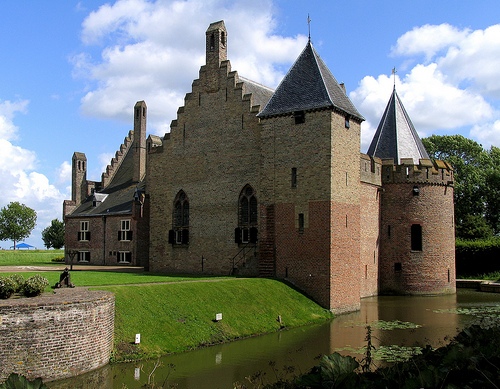

Location: Medemblik, North Holland Map
Constructed: 1288 by Count Floris V
Tel. + (0)22 754 19 60
Radboud Castle, known in Dutch as Kasteel Radboud or Kasteel Medemblik, is a medieval fortress located on the east bank of the harbor in the town of Medemblik, in the province of North Holland, Netherlands. It stands as a prominent historical landmark, surrounded by a moat that enhances its defensive appearance. Commissioned by Floris V, Count of Holland, in the late 13th century, the castle was one of several "coercion castles" (dwangburchten) built to subdue the rebellious West Frisians. Today, it serves as a museum and cultural site, offering visitors a glimpse into medieval life through exhibitions, activities, and events.
The construction of Radboud Castle dates back to the period between
1282 and 1287, though the exact start date is unknown. It was completed
before the catastrophic St. Lucia's Flood on December 13, 1287. Floris
V, who reigned as Count of Holland and Zeeland from 1256 to 1296,
ordered its building as part of a network of five castles aimed at
controlling the West Frisian population after their uprisings. Radboud
is the only one of these castles that remains largely intact; another,
Nuwendoorn Castle, exists only as built-up foundations.
The name
"Radboud" stems from a popular belief that it was erected on the site of
an 8th-century castle belonging to the Frisian king Radboud, though this
is more legend than verified fact. During the 14th and 15th centuries,
the counts of Holland appointed guardians to the castle, which
functioned primarily as a prison and a refuge for the townspeople of
Medemblik rather than a noble residence.
Notable events include its
role in protecting Medemblik residents from raids by the Frisian rebel
Grutte Pier and his Arumer Zwarte Hoop pirates on June 24, 1517. On
August 12, 1588, the castle surrendered to Diederik Sonoy and the Geuzen
during the Dutch Revolt. It was also involved in the Second Siege of
Medemblik. By 1572, with the construction of city walls around
Medemblik, the castle's defensive importance waned, leading to gradual
decay due to dismantling and neglect.
From 1661 to 1734, the great
hall on the southwest side served as a Reformed church, and the square
tower on the west was repurposed as a bell tower. Demolitions continued
in the 19th century: the gatehouse and three towers were torn down in
1850, followed by two more towers in 1870. In 1889, the remnants were
transferred to the Dutch state.
In the 20th century, the castle
briefly stored Rembrandt's famous painting The Night Watch on September
4, 1939, before it was moved to a bunker near Castricum in May 1940
during World War II. From 1897 to 1934, it functioned as a courthouse.
Radboud Castle exemplifies medieval Dutch fortress architecture,
designed as a square coercion castle similar to Muiden Castle, also
built by Floris V. Archaeological research and historical images
indicate it was originally a robust structure with multiple towers and
wings. Today, only two residential wings, two square towers, and one
round tower remain standing.
The castle is constructed primarily from
brick, typical of the region, with steep gabled roofs, conical turrets,
and narrow windows that served both defensive and aesthetic purposes. It
is encircled by a restored moat, which was cleared in 1936 to reveal the
original ground plan more clearly. A fire at a nearby cannery in 1931
exposed the foundations of a tower on the northwest side, providing
insights into its original layout.
Restorations have preserved its
historical integrity. After the state acquired it in 1889, architect J.
van Lokhorst led restorations with advice from R.J.H. Cuypers, focusing
on accuracy. The round south tower was reconstructed during this period.
Further work from 1964 to 1965 removed some 19th-century additions to
align with historical evidence.
Inside, the castle features semi-permanent exhibitions in the "Hemelrijck" area, focusing on medieval themes. The vaults house a museum store and the Castle Cafe, providing spaces for visitors to relax. The museum collection includes artifacts that illustrate the castle's origins, history, and the broader context of West Frisian castles.
Owned by the Nederlandse staat (Dutch state) through the
Rijksgebouwendienst, and managed by the Monumentenbezit foundation,
Radboud Castle is dedicated to preserving and sharing cultural heritage.
It operates as a museum with limited public access, hosting a variety of
activities such as raptor workshops, craft afternoons, medieval markets,
and lectures on its history. The castle is also a popular venue for
weddings, team-building events, and group outings.
Visitors can
explore the site, enjoy lunch at the Castle Cafe, or participate in
guided tours. For ongoing research and deeper historical insights,
resources like Ben Dijkhuis' website dwangburchten.nl are recommended.
While no specific legends are prominently documented beyond the Radboud name association, the castle holds significant cultural value as a symbol of medieval Dutch history and the struggles between the counts of Holland and the West Frisians. It represents the architectural and military strategies of the era and serves as an educational hub for understanding regional heritage. Its role in protecting artworks during World War II adds a layer of modern historical importance. The castle's story is intertwined with the broader narrative of West Friesland's castles, making it a key site for historians and enthusiasts.